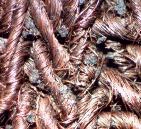
Close up of cloth (3mm across) with particles of soil stuck between the fibres
By Irene Skals and Maj Ringgaard
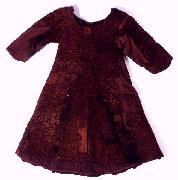 Textiles
found in Danish soil are usually brown, muddy and decomposed. Most of the
finds are waterlogged wool. They used to be dried in air without special
precautions. The result is that particles of dirt and earth cannot now
be removed and the threads are flat and stiff.
Textiles
found in Danish soil are usually brown, muddy and decomposed. Most of the
finds are waterlogged wool. They used to be dried in air without special
precautions. The result is that particles of dirt and earth cannot now
be removed and the threads are flat and stiff.

Close up of cloth (3mm across) with particles of soil stuck between
the fibres
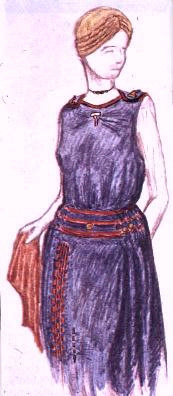 The
original colour is seldom preserved during burial. The textile is coloured
brown through absorption of humic substances. Occasional traces of the
original colour can sometimes disappear as soon as the textile is exposed
to oxygen in the air. The vanished dye can sometimes be identified by chemical
analysis of its remaining components.
The
original colour is seldom preserved during burial. The textile is coloured
brown through absorption of humic substances. Occasional traces of the
original colour can sometimes disappear as soon as the textile is exposed
to oxygen in the air. The vanished dye can sometimes be identified by chemical
analysis of its remaining components.
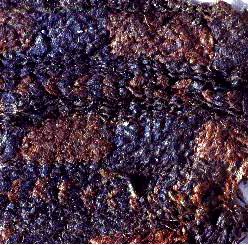
On the right: The girl in blue. This watercolour by M.Ørsnes recreates
the colour and appearance of the costume.
It is always difficult to expose and handle textiles in an excavation without destroying them. Chemical methods for strengthening fragments before lifting were already being tried in 1848:
"On Thursday the 10th of August State Adviser Thomsen and the assistants from the Oldnordiske Museum, Strunk and Herbst, together with Regimental surgeon Ibsen, who had kindly prepared a shellac varnish for the costume's conservation, set out again [to Hvidegaard]..."
"...If these [textiles] had not been impregnated with a consolidating
liquid before one tried to move or lift them, the result would have been
as nearly always happens with brittle finds: everything would fall to dust.
Let us hope that the successful result which crowned their efforts
will lead and encourage others to use the same care and consideration."
(Annaler for Nordisk Oldkyndighed, 1848)
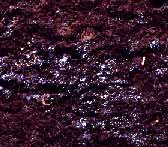
Fragment from Hvidegaard, North Copenhagen. A Bronze Age site excavated
in 1848. The fragment was treated with shellac during the excavation. It
now crumbles at a touch. (detail is 2cm across)
Today, we know that adding a consolidant to textile fibres makes
subsequent Carbon-14 dating and dye analysis difficult. Experience has
shown that it is just about impossible to remove an impregnant after it
has hardened.
We advise, therefore, that textiles should be removed together with
the surrounding soil, so that their extraction can be completed in the
workshop, under the best conditions and without using consolidants.